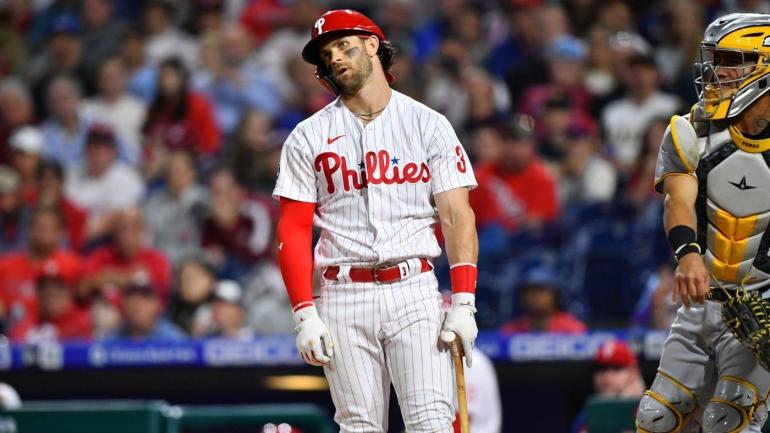
The Philadelphia Phillies were eliminated from postseason contention on Thursday night, ensuring their playoff drought will reach 10 years. (The Phillies, perhaps predictably, have finished at the .500 mark or better just twice in the past decade.) This is as good of a time as any, then, to review the year that was for the Phillies while also daring to look ahead at what's to come between now and next season.
Unlike some of their National League counterparts, the Phillies were not the victims of a late-season collapse. They were most recently in first place on August 14, but they didn't veer off course. Indeed, the Phillies had their best month in August, winning more than 60 percent of their games, before settling into another .500 month -- their third in six tries. Only in May did the Phillies lose more games than they had won.
What went right and what went wrong on a more granular level? Let's examine that.
Stars delivered, mostly
The Phillies have added numerous star-level players to their roster over the past few years: Bryce Harper, Zack Wheeler, J.T. Realmuto. For the most part, those players all did their parts to guide Philadelphia to the promised land.
Harper might win his second Most Valuable Player Award. Entering Thursday, he was hitting .308/.430/.612 (179 OPS+) with 34 home runs and 99 walks. Wheeler figures to earn Cy Young consideration as well. In 32 starts, he amassed a 2.78 ERA (149 ERA+) and a 5.37 strikeout-to-walk ratio. Then there was Realmuto, who, while not on either Harper or Wheeler's level, still homered 16 times and stole 13 bases with a 112 OPS+.
Bryce Harper HR 34 💥💥
— John Clark (@JClarkNBCS) September 25, 2021
He has 46 extra base hits since the All-Star break, most in baseball and most in Phillies history
pic.twitter.com/dcHm68knqh
The Phillies' imported stars did their jobs -- what about the homegrown lot? Rhys Hoskins was limited to 107 games by injury, but he slugged 27 home runs and hit .247/.334/.530 (130 OPS+). Aaron Nola's 90 ERA+ was worse than expected, but he did strike out 5.72 batters for everyone he walked, suggesting he deserved a better fate.
If there were major failures to highlight for the Phillies on the position player side, they were shortstop Didi Gregorius (73 OPS+) and third baseman Alec Bohm (75 OPS+). As for pitching, Philly's various early season attempts at rotation solutions on the pitching side fell flat -- be it Matt Moore, Vince Velasquez, or Chase Anderson.
Suárez emerges
One rotation plug-in that stuck? Ranger Suárez, a 26-year-old left-hander who made an in-season transition from closing to starting. It worked out well:
As a starter: 11 G, 58 2/3 IP, 1.69 ERA, 3.11 SO/BB
As a reliever: 27 G, 40 1/3 IP, 1.12 ERA, 3.00 SO/BB
For as phenomenal as Suárez pitched, it's fair to have reservations about his true talent level. He's a three-pitch pitcher in the sense that he throws two fastballs and a changeup. (He upped the usage rate of his slider to a season-high 12.6 percent in September.) It's possible his arsenal proves to be too thin as the league sees him multiple times. Beyond that, Suárez dominated a slew of opponents that can be charitably described as "not good." In those 11 starts, just two of them came against teams who remained in playoff contention as recently as the start of this week.
Ranger Suárez, Nasty 85mph Changeup. 👌 pic.twitter.com/WcPL7fg97s
— Rob Friedman (@PitchingNinja) August 25, 2021
Of course, the Phillies owe it to Suárez and themselves to enter next spring with him slotted into a rotation slot. It would just be unfair for the Phillies to view him as another frontline starter rather than someone who's more likely to be considered a mid-to-back-end type as the sample size amasses.
Even if that proves to be the case, Suárez is the kind of developmental win the Phillies could use more of if they're going to overtake the Braves next season.
What's next?
Here are, in our estimation, the three most obvious questions facing the Phillies this winter.
1. Does McCutchen return? Andrew McCutchen's contract includes a club option worth $15 million that can be bought out for $3 million. McCutchen is one of the most likable players in the majors, but the Phillies might prefer to have the money given that he's a league-average bat these days.
2. What does the pen look like? Dave Dombrowski seems to be perpetually building a bullpen. This winter will be no different. Veterans Ian Kennedy, Archie Bradley, and Héctor Neris are all scheduled to hit the open market, meaning Dombrowski will have to get creative in restocking his relief corps.
3. Where does Bohm end up? Bohm is a substandard defender at third base, but the Phillies have a first baseman and might prefer a more mobile left fielder. If so, where does that leave Bohm? On the bench, or perhaps with another organization?
The Phillies have a solid roster on paper, one that features numerous in-their-prime stars. The key to their competitive aspirations will once again hinge on whether or not Dombrowski and company can amass enough depth and quality role players around them. If they prove unfit for the task, expect the playoff drought to reach 11 years.


















